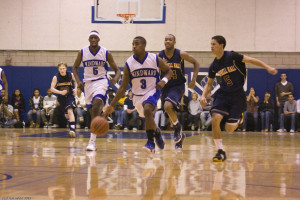5 Common Problems Associated with Fast Break Offense
A Team’s Fast Break can be a very problematic phase of play. For many teams when they reflect back on the statistics associated with a game it may not be unusual for a team to see no points recorded in the fast break area. This is because many teams never look to expose the weaknesses of their opposition to fast break basketball. The fast break phase of a team’s offense can be greatly rewarding and those teams that even become “solid” in the execution of the phase can reap great rewards due to the simple fact many teams only spend a very limited amount of time on defensive drills concerning the fast break.

What makes a poor fast break game such a problem for teams is that it takes away an advantage based phase of a team’s offense. In many of the situations, a fast break occurs a team will have a player number advantage in offense. This may only be brief, but results in the possibility of a high percentage shot against outnumbered defence. Scenarios of 1 v 0, 2 v 1 and 3 v 2 are all common situations that can be seen in fast break phase of play.
Secondly, by not looking to utilise the fast break phase of a team’s offense then this slows a team’s overall offensive movement. Players who feel they do not have to play to the tempo of a fast break during times of opportunity will slow the balls progression rather than force the play or look to push their level of effort. By doing this a team’s commitment to effort based principles of play are weakened because a majority of what makes a fast break finish in a positive outcome is effort.
Five common problems seen in a team’s fast break include:
First Step is Back: if defensive players are not in a low defensive stance they will be slow to move, unable to explode and therefore not able to take part in the fast break. This is most commonly seen in defensive players above the foul line who should be able to lead in a fast break situation but are slow to react and so the fast break opportunity is lost. The first step for a player once a steal is made or fast break initiated must be towards the offensive end of the floor. This is a simple technical aspect of play that makes a fantastic difference to the speed at which a fast break can evolve.
Never Get to a Sprint: a very common problem seen with a lot of teams is that their players never reach a sprint when running in a possible fast break situation. Players often jog, run, but very few often sprint. The difference can be another player in a passing lane for a possible lay-up or reaching the basket that half a second sooner ahead of the defence. A commitment to expending effort and getting into a sprint early is so important.
Don’t Fill Lanes: players often involved in a break, because of the speed and intensity of the situation can make poor decisions in regards to where to run. The key is in training to give players ample experience in a variety of scenarios so they grow accustom to reading the space on the floor and learn how to fill vacant lanes. Filling these lanes provides additional opportunities for passing targets as well as creating problems for the reactive defence in covering all the possible options.
Won’t Pass Ahead: for players who do not practice break situations, another common problem seen is the inability to make a read on the run and select a good passing option. Because of the pace at which opportunities can unfold offensive players must be willing to advance the ball through passing rather than dribbling if the right opportunity presents. Offensive players in a broken play situation will often be more reserved in making passes because they are uncomfortable with making decisions while on the run and at pace. The only way to overcome this is through the simulation in training of these situations and practice, practice and practice some more.
Fail to Attack the Basket Aggressively: In a fast break, all too often the pace is sufficient to create a scoring opportunity but because the offensive players are not willing to attack the basket through a strong driving lane the opening is lost. Once reaching the three-point line players must be aggressive in driving to the basket to make a lay-up or draw a player to make the assist.
The fast break phase of a team’s offense needs to be able to generate some points towards a team’s final score. By not looking to exploit this phase, a team learns to play within their abilities and never push them…






Leave a Reply